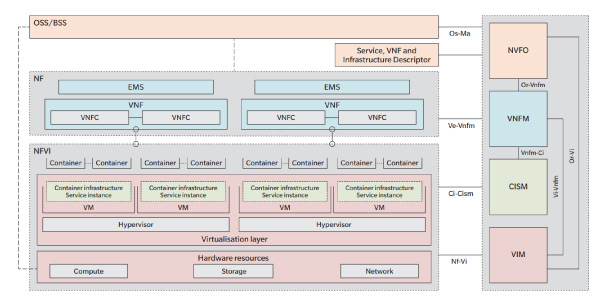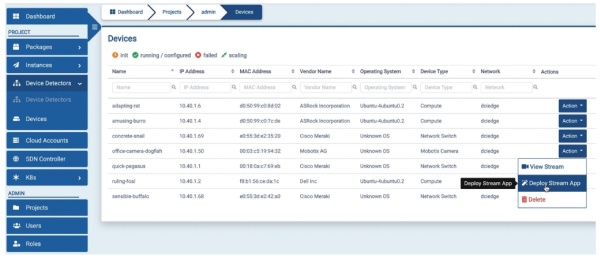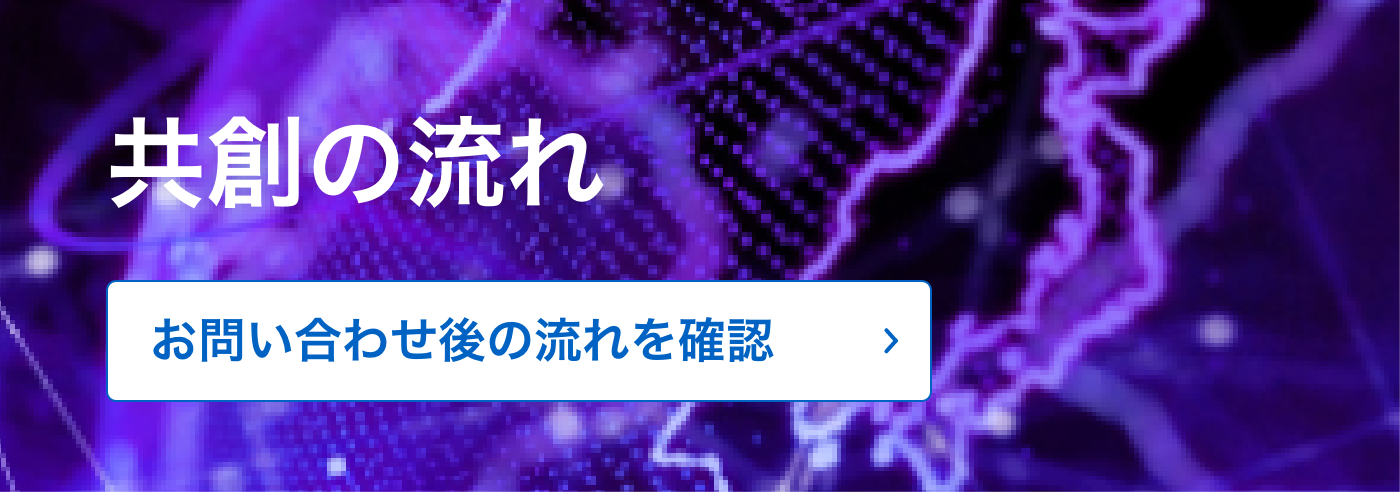1 Introduction
The rapid adoption of cloud services in industrial applications combined with the introduction of 5G networks have enabled hybrid cloud solutions for use cases calling for Artificial Intelligence (AI) and ultra-low latency. Hybrid cloud combines the benefits of edge computing with the vast resource pool and services offered by public clouds by integrating the two systems and giving users the freedom to choose where their data and services are being deployed depending on their performance, cost, and regulatory requirements.
The key enabler for hybrid cloud adoption is the ability to orchestrate resources between private and public clouds. Hybrid cloud orchestration includes functions such as deployment, monitoring, and lifecycle management of public and private cloud services and virtual infrastructure resources to enable comprehensive control over daily operations. This often leads to orchestration solutions that are complex and difficult to use because they are designed to cover a wide range of possible deployment scenarios and services, which in turn makes it challenging and expensive to maintain a hybrid system. However, stakeholders seek solutions that allow them to easily manage their hybrid infrastructure and deployed services that are specific to their needs without superfluous functionality that complicates usability and increases the attack surface of the orchestrator.
Our goal is to develop a modular orchestration solution that is built on open standards so that it can be easily customised to the specific requirements of a user without carrying unnecessary features that affect usability and increase the risk of attack. Essential functionality includes support for multiple cloud vendors, lifecycle management of services, aggregated monitoring for infrastructure and services, a service repository for easy deployment of pre-configured services and finally, a multi-tenant environment to facilitate control over several environments for multiple users. Depending on the use case, additional functionality can include, IoT device detection and management, AI-enabled performance analytics and cost projections, automated multi-site disaster recovery and integration with other systems and services to automate operations such as DevOps and ML Ops.
In this paper, we present the current state of the hybrid cloud orchestration technology, market trends, our recent efforts towards a viable orchestration product and the business value for Konica Minolta International. The rest of the paper is outlined as follows: section 2 briefly covers recent developments in hybrid cloud adoption by SMEs and manufacturing, section 3 presents the Konica Minolta orchestration product, section 4 addresses the business potential for orchestration, section 5 covers future development and finally, section 6 concludes the paper.
2 State of the Art
Existing cloud providers are increasingly competing for taking a larger share of the market. Resource orchestration in the hybrid cloud seems to be one of the vital areas of this competition [1]. As a new trend, the multi-cloud (i.e, to use more than one public cloud provider) paradigm further complicates the orchestration market, as it introduces multiple cloud providers to a single hybrid cloud architecture [2].
In the hybrid cloud space, the existing cloud resource orchestration tools can be divided into two broad groups [3]: The first group provides solutions by major public cloud providers. These solutions are equipped with a comprehensive set of native management tools that are highly integrated with the cloud platform and provide tailored capabilities — for example, Google Anthos [4], AWS cloud formation [5], Azure resource manager [6]. In addition, it is worthy to note that for hyper scalers, orchestration solutions are a delivery vehicle for their cloud-first strategy. Therefore, they are not enabling vendorneutrality. The second group’s solutions are provided by third parties. Third-party tools are commonly cross-platform and multifunctional. While most thirdparty tools are vendor-neutral, they are designed in a way to have less depth in their functionality. Additionally, the wider scope of use-cases supported causes them to be more complex to deploy and maintain. Some examples of these tools are Cloudify, Morpheus, and Hashi Corp stack.
Not following the existing standards is causing most orchestration solutions (i.e., groups one and two) to suffer from a lack of interoperability. Interoperability in this context refers to the compliance with a common standard for describing the configuration of infrastructure and services, thus avoiding vendor lockin and relying on a common unified language and model across solutions by different vendors. In [7], by looking at different use cases and definitions, the authors attempted to identify the state of the art of interoperability in the current cloud ecosystem. To address this challenge, all the artefacts presented in this work follow the European Telecommunications Standards Institute (ETSI) Management and Orchestration (MANO) standardisation framework.
It is also important to note the connection between AI solutions and orchestration. To support AI applications and machine learning pipeline requires a complex architecture that is commonly expanded between cloud and edge. The rise of the hybrid and distributed cloud made AI solutions easier to be built and operationalised and ready to be offered to the public. Each AI solution has at least three separate and sometimes complex pipelines: Data Engineering, Model Engineering, and Deployment of services. Without a suitable orchestration tool, the Provisioning and orchestration of these pipelines and their components can be burdensome and costly. On the other hand, AI through AIOps makes the hybrid-cloud orchestration intelligent by enhancing workload fitment, cost analysis, real-time decision-making, and policy optimisation. In the context of a cloud-native application running on a hybrid cloud infrastructure the monitoring and maintenance are very complex and error-prone tasks as a) infrastructure components are heterogenic, b) lack of application layer traceability, c) overhead of instrumentation and d) lack of synchronisation across a microservice-based distributed system. Therefore, AIOps is a necessity of any modern platform [8] [9]. Both AI platforms and AIOpsenabled orchestration are aiming to make the service better, predictable, and scalable.
2022 is being deemed as the year of economic uncertainty and business anxiety. The coming years require the flexibility and scalability of cloud services to adapt to constantly changing market conditions. The COVID-19 pandemic’s effects will last well past 2022. During the past two years, many organisations faced unprecedented demand on their infrastructure. Consequently, many SMEs and enterprise IT organisations adopted cloud computing (hybrid, cloud-first and distributed). Gartner forecasts that the trend will continue [10] and in the coming years we will see a surge in the emergence of innovative technologies (e.g., IoT and AI). These, in turn, will create the need for tools that enable cloud implementations, encourage cloud adoption and tie cloud services ever closer to the user’s premises. As a result of this, it is expected that hybrid cloud computing will expand at a compound annual growth rate of 18.73% over the forecast period 2021 – 2026, from a market valued at USD 52.16 billion in 2020 to reach USD 145 billion by 2026 [11].
Konica Minolta’s orchestrator is being developed in conjunction with partners in the AI-NET ANIARA project funded through the Celtic-NEXT cluster for next generation communications. In the context of this consortium, our orchestrator is built to support new and more demanding use cases for telecom operators and industrial IoT verticals. The project is focused on enhancing edge computing architectures for next-generation smart manufacturing and cities. KM orchestrator will support all the key requirements of the next-generation applications such as Slice-as-aService, Function-as-a-Service, and microservices. The orchestrator will play a vital role in enhancing the use case narrative by supporting AI automation, lightweight containers, and efficient power usage [12]. Details of KM orchestrator and its components are presented in Sect 3. Challenges and Business Potential are shown in Sect. 4. Current Development and Future Work are explained in Sects. 5. Ultimately, the study is concluded in the Sect. 6.
3 Konica Minolta Orchestrator
3. 1 ETSI MANO Compliance
The Konica Minolta Orchestrator is built on the MANO standard [13]. The standard defines the architecture (Fig. 1) of hybrid cloud orchestration and is extensively used in modern 5G networks for hosting and managing network functions [14] and services. By complying with a standardised architecture, we are able to extend the functionality of the orchestrator within a well-defined framework while maintaining a solid foundation for the future. Furthermore, our compliance with a widely accepted standard, allows us and our partners to interface the orchestrator with existing systems based on our standardised APIs (application programming interfaces).
For our clients, this means that the Konica Minolta orchestrator is transparent and can be customised to suit their exact requirements, even by third parties, provided they comply with the standard. Consequently, Konica Minolta can offer a customised solution to partners and clients which can be independently interfaced with third-party systems, giving them full control over how they use the software.
As per MANO standards, we employ a hierarchical data structure to describe the services deployed to clouds. At the top layer of the structure is the Network Service (NS) which describes the entire service to be deployed and the connections between the components of this service. The components of the service are called Virtual Network Functions (VNF) and they are a collection of independent elements that build a specific function within a network service. In most instances, a VNF describes a Virtual Machine (VM) but the data structure can map several VMs into a single VNF, depending on the complexity and number of components that are needed to build a given function. Physical Network Functions (PNF) are also supported which means that we can also manage physical devices within an infrastructure. For example, we can configure switches and routers to set up a Virtual Private Network (VPN) or change the routing tables and forwarding behaviour.
The orchestrator can store NS and VNF descriptors [13] locally for each user or through public or private repositories. These descriptors are plain text files that can be selected by the end user and deployed to a cloud of their choice. They can also be customised, if necessary, to suit a specific use case. The same template can be used for different clouds, negating the need to write several descriptors for the same service depending on which cloud it needs to be deployed. The translation between the standardised TOSCA descriptor language and the proprietary cloud APIs is managed by the orchestrator, negating the need for having specific knowledge on how to operate each cloud.
Monitoring and lifecycle management of services is supported by the orchestrator at distinct levels. The most basic monitoring occurs at the virtual infrastructure level. The orchestrator will monitor deployed VMs to ensure if they are still operational. In most cases, this uses the cloud API to probe the liveness of deployed VMs. Furthermore, the orchestrator supports application health monitoring on condition that the deployed application provides an API for health checks. The orchestrator has the capability of showing real-time metrics from the cloud infrastructure such as the processor load and network traffic per virtual machine. The collected metrics can be stored and analysed to create reports on utilisation patterns and trends using machine learning.

Fig. 1 ETSI MANO reference architecture.
3. 2 High-Availability and Disaster Recovery
High-availability and disaster recovery functionality are fully supported, as well as, scaling of services based on current load and estimated load using machine learning prediction. For high availability, the orchestrator fully supports applications deployed in containerised form using container orchestration engines. In addition, it is capable of scaling existing services by deploying additional VMs when needed, which are automatically added to the container orchestration engine as worker nodes to balance additional load. Similarly, disaster recovery is handled directly by the orchestrator through monitoring the liveness of services and public clouds. An automated failover system allows users to select a backup cloud for their applications which will be used by the orchestrator to automatically redeploy the services in the event of a localised infrastructure failure.
3. 3 Integration with Konica Minolta Products
Device discovery is supported by the orchestration and is one of the first extensions we have applied on the standard. We have implemented automated device discovery by scanning the network for known Mobotix camera MAC addresses. This is currently an experimental feature to demonstrate the capability of the orchestrator and we expect future versions to integrate with Mobotix cameras in a more robust way that will not require scanning the network actively to detect new cameras. Upon detecting a Mobotix camera (Fig. 2), the orchestrator lists under the device menu and because it is identified as Konica Minolta equipment, it is automatically aware of which services are compatible with the camera and allows the user to deploy the relevant services (such as computer vision) to a cloud of their choice. Furthermore, the orchestrator can directly access the live feed from the camera or redirect the user to the deployed application which manages the camera and streams the live feed. With this feature, we are aiming towards vertical integration of Konica Minolta software and hardware products, making it easier to support our products and provide services to our clients.
The orchestrator itself can be easily deployed to individual servers, laptops, public and private clouds through automated scripts. The deployment uses containerised instances of the orchestrator modules that are configured for high availability to provide a robust platform for managing our services. Furthermore, this modular approach allows us to customise specific functions for our clients, offering them a bespoke solution for their enterprise and industrial networks that eliminates unnecessary complexity and offers a clean solution that targets their specific requirements. In turn, this enables us to pre-configure the orchestrator with relevant Konica Minolta products and services and easily deploy and maintain custom orchestrator instances for each of our clients.

Fig. 2 Mobotix camera detection and service deployment.
4 Challenges and Business Potential
From a business perspective the main advantage offered by an orchestrator is the simplification of daily workflows and reduction in operating costs through the introduction of automation and unified management tools, which in turn accelerates the delivery of integrated services. Furthermore, an intuitively designed orchestrator which is built to the requirements of a use case will improve the overall quality of experience for the users. An easy-to-use orchestration tool enables a greater “democratisation” of the resources and user’s interaction with them. The tool will automate the management, coordination and organisation of complicated IT systems, services, and middleware. Finally, through automation, the tool will reduce employee involvement and eliminate potential errors in provisioning, scalability, or other complex cloud processes. For this reason, in digital R&D we are focusing on a set of features that offer customers an intuitive framework, with self-service functionality and unified management that accelerates the provisioning of resources, enables end-users to keep track of the actual and estimated costs of infrastructure while offering a better way of managing them.
There exists a quandary between pure sales (reselling) in contrast with internally generated proprietary (IP) Intellectual Property approaches. DCI’s strategy is to integrate existing IPs and generate new ones. Our solutions are creating an ecosystem in which our customers’supply services to run on our platforms. It is worthy to consider that, the tech data and code do not directly result in IPs, The IP depends on the uniqueness and novelty of the platform. The ecosystem is aggregating users’IP and provides a mature platform that increases their chances of success. The ecosystem should be formed in a structured manner, with a strategy, which is not only focusing on re-sale. From this perspective, the business model of Konica Minolta will change. We will play the role of an ecosystem-builder that offers the value proposition on its platform. The path is evolutionary. First, we become aggregators, then orchestrators of solutions and facilitators of relations between all the ecosystem’s participants. As the ecosystem provider, we will position Konica Minolta at the centre. We build partnerships that make our customers do more business with their customers. This can be monetised in a plethora of ways such as revenue sharing, charging partners a flat fee, charging partners for API usage, charging customers to use the integrations.
DCI solutions (KM Orchestrator, and ML pipelines) are offered in a way that are helping the users to avoid hyper-scale cloud providers’ lock-ins, ability to scale resources seamlessly as the workload grows and to take control and decide where to place their data. Also, having transparency and a single pane of glass view makes it possible for the company to position itself as an application service provider, easily responding to the compliance requirements imposed by IT Operations.
Utilising the orchestrator means the speed of delivery is increased, automation and governance operational management costs are lowered, and release times are shortened. In addition, parallel development initiatives and service degradation issues can be more easily managed and controlled, supporting different technologies, and operating on multiple cloud providers.
From the end-user’s perspective, an orchestrator can ensure greater stability in applications, provide new features faster, improve communication and collaboration between Development and IT Operations. It is, therefore, possible to invest in innovation the time previously spent in management activities.
5 Current Development and Future Work
DCI is currently engaged in several governmentfunded projects within the UK and the EU. The CelticNEXT AI-NET is a project focusing on next generation manufacturing. One of the branches of the project is ANIARA (Automation of Network edge Infrastructure & Applications with Artificial Intelligence) which deals with orchestration in manufacturing. At the first consortium demo event, we demonstrated our orchestrator as a viable solution for industrial IoT device detection and management as well as disaster recovery scenarios using a combination of edge, private and public clouds.
As part of ongoing development, we are currently in the process of implementing additional features to the orchestrator that will introduce essential capabilities in infrastructure monitoring and lifecycle management. Our goal is to have a complete monitoring solution for infrastructure and services, allowing users to retrieve detailed metrics and service logs though the orchestrator. The two aspects of this are aggregated metrics from the physical and virtual infrastructure and aggregated logging for distributed (cloud-native) services. We are aiming to provide this functionality through the orchestrator to make it easier for the users to have a holistic view of the state of infrastructure and services and for developers to easily trace events in the logs.
Maintaining performance metrics at the orchestrator also enables us to perform analytics using machine learning and produce performance analysis reports including utilisation patters and trends. This in turn will enable us to build pre-emptive scaling algorithms at the orchestrator which will anticipate service demand and adjust service resources accordingly.
Another aspect of the orchestrator we aim to improve over the next development cycle is the service builder interface. At present, the users define services in text files that describe the virtual machines and software packages to be installed on deployment. To improve usability, we aim to produce a new graphical interface that will allow users to build services with simple drag-and-drop functions and context menus. The interface will also include a logical representation of deployed services, showing the topology and relations between services and allow the user to query detailed information for each service through the topology map.
6 Conclusions
The In conclusion, our paper introduces the Konica Minolta orchestrator, its design philosophy, and the set of features that differentiate it from other orchestrators. The orchestrator is built on the European Telecommunications Standards Institute (ETSI) Management and Orchestration (MANO) standards and is modular by design, By adopting this orchestration solution, the vast number of connected devices on the Internet of Things (IoT) creates an enormous potential for new applications, by leveraging synergies arising through the convergence of consumer, business and industrial Internet, and creating open, global networks connecting people, data, and “things”. In this context, the project aims to develop a patterndriven framework, built upon FORXAI [15] platforms and Internal KM’s Systems, to enable and guarantee secure and dependable actuation and semi-autonomic behaviour in IoT/Industrial, Imaging applications and Intelligent Process Automation.



